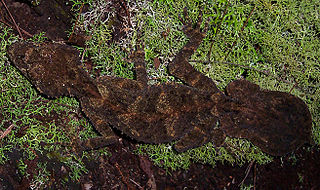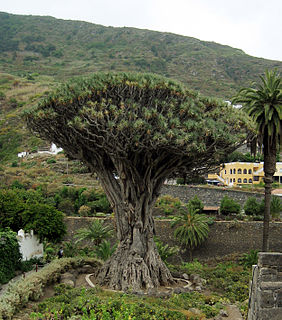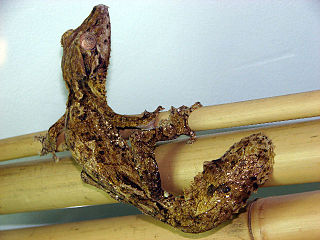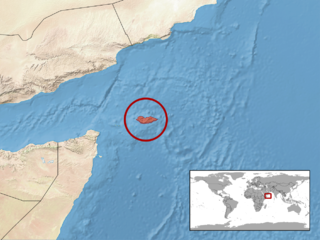
Geckos are small lizards belonging to the infraorder Gekkota, found in warm climates throughout the world. They range from 1.6 to 60 cm.

Lizards are a widespread group of squamate reptiles, with over 6,000 species, ranging across all continents except Antarctica, as well as most oceanic island chains. The group is paraphyletic as it excludes the snakes and Amphisbaenia; some lizards are more closely related to these two excluded groups than they are to other lizards. Lizards range in size from chameleons and geckos a few centimeters long to the 3 meter long Komodo dragon.

Phelsuma is a large genus of geckos in the family Gekkonidae. Species in the genus Phelsuma are commonly referred to as day geckos.

Hemidactylus is a genus of the common gecko family, Gekkonidae. It has 168 described species, newfound ones being described every few years. These geckos are found in all the tropical regions of the world, extending into the subtropical parts of Africa and Europe. They excel in colonizing oceanic islands by rafting on flotsam, and are for example found across most of Polynesia. In some archipelagoes, cryptic species complexes are found. Geckos like to live in and out of houses. They have been introduced to Australia.

Uroplatus is a genus of geckos, commonly referred to as leaf-tail geckos or flat-tailed geckos, which are endemic to Madagascar and its coastal islands, such as Nosy Be. They are nocturnal, insectivorous lizards found exclusively in primary and secondary forest.

Pristurus is a genus of geckos endemic to Arabia and Socotra Island as well as the Middle East and the Horn of Africa. Species of Pristurus are commonly known as rock geckos .

Saltuarius is a genus of larger Australian geckos, known collectively as leaf-tailed geckos. The genus was created in 1993 to accommodate some former members of the genus Phyllurus. These geckos appear very similar to the Uroplatus geckos native to Madagascar. However, this is a convergent evolution.

Socotra or Soqotra, located between the Guardafui Channel and the Arabian Sea, is the largest of the four islands in Socotra Archipelago. The territory is located near major shipping routes and is officially part of Yemen, and had long been a subdivision of Aden Governorate. In 2004, it became attached to the Hadhramaut Governorate, which is much closer to the island than Aden. In 2013, the archipelago became its own governorate: Socotra Governorate.

Dracaena is a genus of about 120 species of trees and succulent shrubs. In the APG IV classification system, it is placed in the family Asparagaceae, subfamily Nolinoideae. It has also formerly been separated into the family Dracaenaceae or placed in the Agavaceae.

Dragon's blood is a bright red resin which is obtained from different species of a number of distinct plant genera: Croton, Dracaena, Daemonorops, Calamus rotang and Pterocarpus. The red resin has been in continuous use since ancient times as varnish, medicine, incense, and dye.

Henkel's leaf-tailed gecko, also known commonly as Henkel's flat-tailed gecko or the frilled leaf-tail gecko, is a species of gecko, a lizard in the family Gekkonidae. The species is endemic to Madagascar.
William Robert Ogilvie-Grant was a Scottish ornithologist.

Gekko gecko, the tokay gecko, is a crepuscular arboreal gecko in the genus Gekko, the true geckos. It is native to Asia and some Pacific Islands.

The Socotra Island xeric shrublands is a terrestrial ecoregion that covers the large island of Socotra and several smaller islands that constitute the Socotra Archipelago. The archipelago is the western Indian Ocean, east of the Horn of Africa and south of the Arabian Peninsula. Politically the archipelago is part of Yemen, and lies south of the Yemeni mainland.

Dracaena cinnabari, the Socotra dragon tree or dragon blood tree, is a dragon tree native to the Socotra archipelago, part of Yemen, located in the Arabian Sea. It is so called due to the red sap that the trees produce.

The Phyllodactylidae are a family of geckos (Gekkota) consisting of approximately 148 species, distributed throughout the New World, North Africa, Europe and the Middle East. The Phyllodactylidae were described based on a molecular phylogenetic analysis in 2008 and all members possess a unique single codon deletion in the phosducin (PDC) gene. The phyllodactylid genus Bogertia has been recently synonymized with Phyllopezus.
Dragon's blood is a bright red resin obtained from a number of distinct plants.

George Basil Popov, was a Russian-British entomologist born in Iran, his father having been employed there by the Imperial Bank of Persia. Popov became an authority on the Desert locust.

The Socotran rock gecko is a species of gecko. It is endemic to Socotra.

















